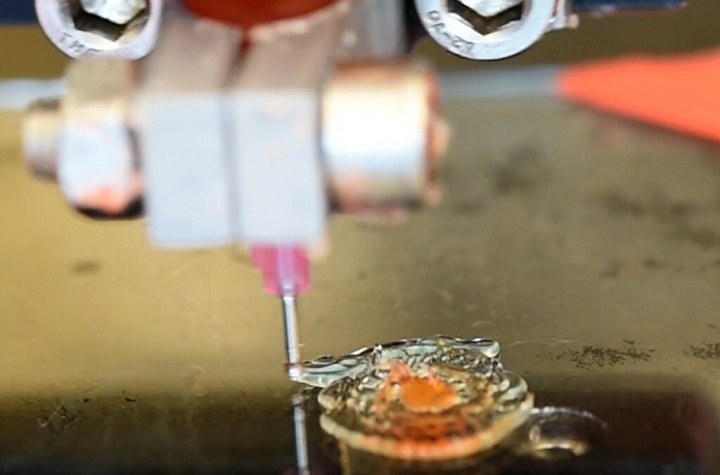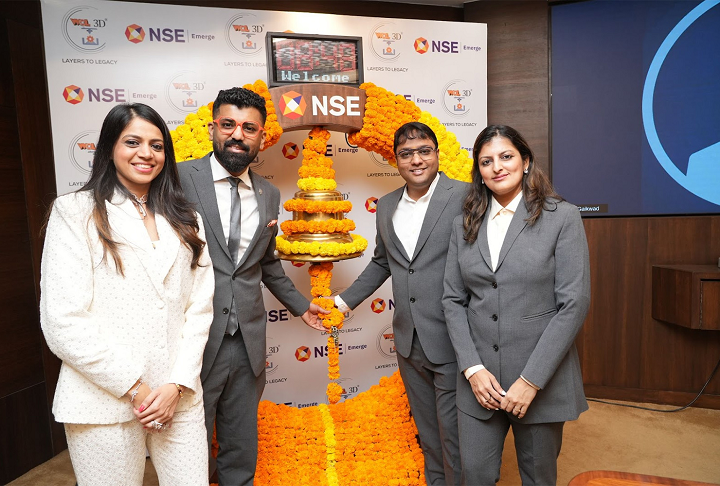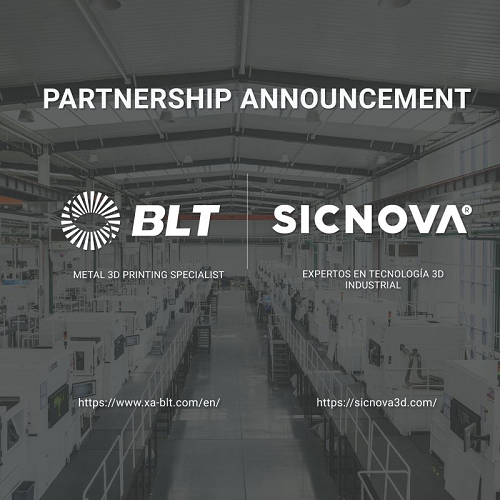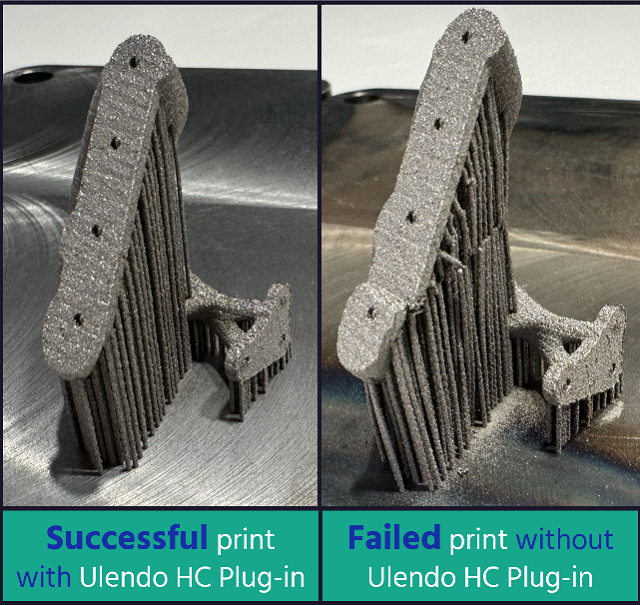In 3D Printing News Briefs today, WOL3D India recently celebrated its IPO, while BLT signed a distribution agreement with Sicnova and SPEE3D announced a funding partnership with dual-use security investment fund 1941. JuggerBot 3D has announced its partners for an AFRL project, and Ulendo introduced the first add-in software for Dyndrite’s LPBF Pro platform. Finally, researchers developed a self-improving AI method that enables more efficient 3D printing of intricate structures.
WOL3D India Celebrates Initial Public Offering
WOL3D India Limited, a top 3D printing distributor and manufacturer in India, announced its Initial Public Offering (IPO) in early September, making it the country’s first listed 3D printing company. This is a major milestone for not only WOL3D, but also for India’s additive manufacturing sector. When founded, the company’s goal was to make 3D printing both affordable and accessible, and it now collaborates with over 100 resellers (like Flashforge), offers over 200 products, and has offices in more than 14 cities. WOL3D also established a 3D Printing Experience Center in Mumbai, and was featured on the second season of Shark Tank. Its IPO, which aims to raise up to $3.03 million, should help fund its growth and strengthen its place in the AM market.
The company’s IPO issue period was from September 23-25, on the National Stock Exchange (NSE) Emerge Platform, with an official listing date of September 30th. The initial public offering was 17,04,000 shares, and investors could bid for a minimum of 1,000 shares at $1.69-$1.78 per equity share. According to a WOL3D blog post, the company “collected 347 times as many subscriptions by the closing date on September 25.” The founders and other teammates gathered to ring the bell, and afterward, everyone shared a fun evening of team building, dancing, food, and fun.
BLT Announces Distribution Agreement with Sicnova
Chinese metal laser powder bed fusion (LPBF) solutions provider Xi’an Bright Laser Technologies (BLT) has announced a new partnership with Sicnova, a 3D printing technology supplier in Latin America and the Iberian Peninsula. The two have signed a distribution agreement, which will allow BLT to significantly expand its turnkey solutions in the Spanish and Portuguese markets. BLT has nearly 2,800 global clients, including in its home country of China, as well as North Africa, Australia, North America, Europe, Asia, the Middle East, and more. This year alone, the company signed distribution agreements with partners in Nigeria, Korea, and Poland.
Sicnova, founded in 2007, is the official exclusive distributor for multiple leading 3D printing and scanning technology brands, including Formlabs, HP, Markforged, Nano Dimension, Bambu Lab, Ultimaker, Shining 3D, and others. It offers certified technical qualifications to provide customers with services in CAD design, equipment installation, training, and maintenance. Thanks to this new partnership, Sicnova will bring over 20 BLT 3D printer models to its customers, as well as end-to-end service, full access to BLT’s latest materials, and strong post-sales support.
SPEE3D’s Funding Partnership with Dual-Use Investment Fund
Top Australian metal 3D printing company SPEE3D announced a funding partnership with dual-use national security investment fund 1941, jointly owned by Bondi Partners and Ellerston Capital. SPEE3D is said to provide the only in-field 3D printer that’s used in combat zones for Australia and its allies, and it’s partnered with the Australian Department of Defence, the U.S. Department of Defense (DoD), the U.K. Ministry of Defence, the Ukraine Army, the Japanese Ministry of Defence, and others. Several of SPEE3D’s printers were also recently deployed as part of the DoD’s Rim of the Pacific (RIMPAC) exercise in Hawaii. 1941’s mission is to find and invest in the next generation of U.S. and Australian success stories that focus on national security dual-use businesses and technologies across the Indo-Pacific. In this funding deal, 1941’s investment will help SPEE3D grow its global business and supply more of its patented Cold Spray Additive Manufacturing (CSAM) technology.
“Our partnership with 1941 will help us to grow quickly and meet the growing global demand for our technology. 1941 and Bondi Partners have extensive military ties with the U.S. military and other allied nations and our partnership aims to build on this great Australian success story,” said SPEE3D’s CEO Byron Kennedy.
JuggerBot 3D Chooses Technical Partners for AFRL’s Hybrid AM Project
Industrial 3D printer OEM JuggerBot 3D, based in Youngstown, Ohio, recently announced its key technical partners for a hybrid large-format AM project through the Air Force Research Laboratory (AFRL), also in Ohio. The $4 million congressional award, funded by the Office of the Under Secretary of Defense for Research and Engineering Manufacturing Technology (OSD(R&E)), hopes to enable production of faster, less expensive tooling for the aerospace and defense industry by advancing large-scale hybrid AM. Due to their expertise in Fused Granulate Fabrication (FGF) and Direct Ink Writing (DIW) composite manufacturing, Mississippi State University’s Advanced Composites Institute (ACI) and Oak Ridge National Laboratory (ORNL) were selected to help with R&D efforts of production workflows using thermoplastic and thermoset deposition. Together, these three will work to create reliable process parameters to ensure consistent material deposition.
A key part of the project will be developing a system—designed to reach build volumes of 360 ft³—that integrates two-part resin and pellet-fed (FGF) material extrusion to process both performance-grade thermoplastic polymers and advanced thermoset resin inks, including vinyl esters and epoxies. ORNL will support advanced tool path generation software, building on previous Collaborative Research and Development Agreements (CRADAs) about sophisticated AM processing, like JuggerBot 3D’s Bead Characterization System (BCS). JuggerBot 3D will develop and integrate thermoset Material Cards, and work with ORNL to improve slicing software and printer hardware to process thermosets independently, but simultaneously, with thermoplastics. The ACI will be leading system-level validation, including material testing and assessment (MT&A) to make sure that the established process parameters for the thermoplastic and thermoset materials are effective. The resulting system will support the warfighter at the speed of battle.
Dyndrite Welcomes First LPBF Pro Add-in by Ulendo
Dyndrite has welcomed the first add-in software for its LPBF Pro platform—Ulendo HC (Heat Compensation), which optimizes laser paths to reduce heat-induced stress and deformation in metal AM. These heat-related issues can result in wasted material, longer production times, and failed prints, and until now, manufacturers have engaged in trial and error to create effective scan strategies. By integrating Ulendo HC into Dyndrite’s LPBF Pro software, users can automatically analyze and adjust the laser path, using an advanced algorithm. The company says this lowers mean deformation by 50%, and residual stress by 88%, and leads to improved quality, major cost savings, and more successful prints. It’s described as a “plug and play” solution: users just activate the tool through Dyndrite LPBF Pro’s APIs, and optimization happens automatically. The benefits of Ulendo HC are great for manufacturers using LPBF to print parts from expensive metals, or ones that need a lot of post-processing to manage heat-induced deformation and stress.
“Our goal is to enable customers to print new materials, print faster, print features like thin walls, print without supports and improve surface finish. Our tools can be combined with tools like the one Ulendo provides to accelerate this goal. We welcome Ulendo as the first company to provide add-in software to the Dyndrite LPBF Pro platform,” said Dyndrite CEO Harshil Goel. “With the addition of Ulendo HC to the platform, we are working toward our collaborative vision of Dyndrite LPBF Pro as a powerful metal 3D printing engine into which innovative companies like Ulendo can integrate their software add-ins and features. I’m excited to see what new ways Ulendo will use our powerful core tools to achieve previously difficult prints for our customer base.”
Researchers Develop Self-Improving AI Method for 3D Printing Efficiency

WSU researchers used an AI technique to train and find the optimized 3D printing settings to create intricate kidney and prostate organ models. The work could improve 3D printing manufacturing of intricate designs for flexible electronics, wearable biosensors and other devices.
It can take a long time to come up with the correct settings for 3D printing, such as printer configuration, materials, and the nozzle’s dispensing pressure. But researchers at Washington State University developed a self-improving artificial intelligence (AI) method that could allow for more efficient, seamless 3D printing of intricate structures and designs, which could have applications in flexible electronics, artificial organs, and wearable biosensors. As they explained in their study, the team’s “general-purpose machine learning algorithm” learned to identify, and then produce, the best versions of kidney and prostate organ models. They used a technique called Bayesian Optimization to train the AI and find optimized 3D print settings. Then, once training was complete, the researchers were able to optimize three objectives for their organ models: weight or porosity, geometry precision, and printing time. Plus, because the algorithm is “broadly generalizable,” it’s easy to make small changes to achieve optimized organ models.
“That means that this method can be used to manufacture other more complicated biomedical devices, and even to other fields,” explained Kaiyan Qiu, co-corresponding author on the paper and Berry Assistant Professor in the WSU School of Mechanical and Materials Engineering.
Subscribe to Our Email Newsletter
Stay up-to-date on all the latest news from the 3D printing industry and receive information and offers from third party vendors.
You May Also Like
The Third World War & The Disruption of US Military Power
A Reddit user once remarked, “The most terrifying capability of the United States military remains the capacity to deploy a fully operational Burger King to any terrestrial theater of operations...
Australia to Go Orbital: Gilmour Space Gears up for Historic Launch
Australia is on the brink of a historic achievement in space exploration. Gilmour Space Technologies, a pioneering company based on the Gold Coast, has secured the nation’s first-ever orbital launch...
3D Printing Webinar and Event Roundup: November 10, 2024
We’ve got another busy week ahead of webinars and events around the world! There are multiple open houses and conferences, advanced AM training, a 3D printer launch event, our own...
3D Printing News Briefs, November 9, 2024: Concept Car, Afloat 3D Printing, & More
In today’s 3D Printing News Briefs, we’ll start with business, as Anisoprint appointed AM industry veteran Tuan TranPham as President of the Americas and APAC. Then we’ll move onto automotive...









































